|
Seeing Double: Investigating Unknown Double Stars Ashley Ekpo, Howard Community College Mentored by: Anna DeJong, Ph.D. |
Abstract
Double stars are two stars that appear coupled after years of observations. They can either be binary stars, which are gravitationally bound to each other, or simply appear in the same line of sight from Earth. We researched three double star systems with previous observations that had not been confirmed to be gravitationally bound. This project sought to obtain new location data, calculate their celestial coordinates, and plot measurements alongside historical data to determine whether each system is binary. We also sought to update the collective position data for these systems. We used right ascension and declination (the astronomical equivalents of latitude and longitude) to measure the angle and separation between the stars to determine each system’s current location. Our findings suggest that system A (WDS 05331+0228 AG 96) does not appear to be binary, while systems B (WDS 07242+1428 J 396 AB) and C (WDS 05145+3634 SEI 114) may be binary but require further measurements for confirmation. Our collected data and calculations were added to the WDS catalog for future analysis by researchers. Additional data analysis and continued observations will be necessary to reach definitive conclusions about these systems.
Introduction
Double stars are two stars that appear close together in the sky. Some double stars are visual only, in that they merely appear to be close together. This is due to parallax, which occurs when an object’s position appears to change because of a shift in the observer’s point of view [1]. Physical double stars are gravitationally bound to one another and orbit a shared center of mass. Physical doubles are referred to as binary stars. Some binary stars share material, with the recipient pulling stellar material from the donor star [2]. Binary systems can evolve together, as the death of the donor star (the smaller star) can expedite the death of the primary (the larger star) as materials are transferred [3]. Some binary systems can become supergiants, which are larger and brighter than the Sun [4,5]. Increasing fusion reactions can then result in an explosion called a supernova, eliminating the evidence of the system’s existence. Larger mass binary systems may result in stellar remnants known as neutron stars, comprised of compressed neutrons, or black holes [2]. Elliptical changes in relative motion indicate the binary nature of a system.
Background
The first documented double star was observed by the astronomer Ptolemy (c.100- c.170AD), entitling it “diplous”, which he observed with the naked-eye [6]. Upon the emergence of the telescope, Benedetto Castelli noted another double star system in the 17th century, consulting with Galileo for its analysis. During the same century, an astronomer, Giovanni Battista Hodierna, compiled a short record of double star findings. Astronomers continued to observe double, triple, and quadruple systems, but the first catalog of observations was not created until the 18th century by astronomer Christian Mayer, which “contained 72 double stars” [6]. A comprehensive longitudinal study of double star observations began with astronomer William Herschel in the late 18th century. Herschel first discovered the function of stellar parallax and defined binary systems as the “union of two stars, that are formed in one system, by the laws of attraction.” [7]. Early observations utilized visual micrometers, which were attached to telescopes for the purpose of measurement. Later, photography aided in system measurements.
In the modern day, speckle interferometry uses light inference for observations once too small to be seen visually. The Washington Visual Double Star Catalog (WDS) maintains the world’s primary double star database and merged previous observation data [8]. The database contains the history of each double star system, including date of observation, position, separation, position angle (angular orientation relative to the other star), magnitude, spectra, and other data points. WDS data is housed at the US Naval Observatory in Washington, D.C. and is available online. Some findings have been published in books and scientific magazines, but today, many reported findings are available in the Journal of Double Star Observations (JDSO). Double star research is a collaborative effort by professional and amateur astronomers as well as physicists who work to compile a more complete record of the movements of these systems throughout our solar system. Because up to half of all stars may become part of binary systems over time, this effort requires a global and generational contribution to chart and project the implications of these stellar relationships [2].
Objectives
Double star research is germane to both the solar historical record and projections for the future. Using telescopic observations, we can measure the location of the secondary star at a given point in time. These measurements, in conjunction with others taken over hundreds of years, help determine if there is an elliptical pattern. If enough data provides evidence of an ellipse, we may be able to make an argument that the double stars are binary in nature. The goal of this research is to add current position data to the historical record and publish it for public access to the greater double star community. Doing so will contribute to the longitudinal findings of these systems and will allow for more accurate conclusions about whether these systems are binary and what we may expect for their outcome in the future.
Methodology
Utilizing Stelle Doppie, the WDS double star searchable database, we researched double star systems that have not yet been determined to be gravitationally bound. Selection criteria for the uncertain double star systems included the following: right ascension between 2-12, magnitude per square arcsecond between 9-11, delta magnitude less than 4, and separation between 5-10″.
Instruments
Observations were made via remote request from the Las Cumbres Observatory (LCO) global telescope network for measurements of all three systems between March 2024 and September 2024. A total of 30 images (10 per system) were captured using a 0.4 meter telescope with SBIG and QHY600 cameras, Bessell V filter, and an exposure time of 3 seconds [13].
Specifically, the observations were conducted in partnership with the Astronomical Observatory in South Africa, the Cerro Tololo Inter-American Observatory in Chile, and the Teide Observatory in Spain, as shown in Figure 1.
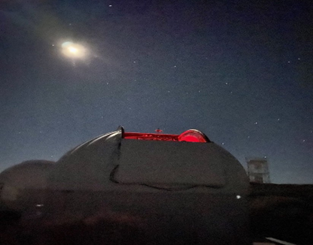
Figure 1: 0.4 m telescope located at one of Teide Observatory’s sites [14]
Measurements
Images from the LCO database were downloaded, reduced, and analyzed using Afterglow Workbench (see Figure 2), a software which allows for image scaling, measurement and labeling. Afterglow Workbench allows for measuring the angular separation and position angle (PA) between the primary and secondary stars. Saturation levels were adjusted to optimize the image clarity with clean separation of the stars. Finally, the right ascension (RA) and PA were confirmed to match Stella Doppie.

Figure 2: Afterglow Workbench sample measurements of the three systems: Figure 2a: WDS 05331+0228 AG 96 (HD 288012) Figure 2b: WDS 07242+1428 J 396 AB and Figure 2c: WDS 05145+3634 SEI 114 (HD 280693)
A total of 10 measurements were taken to minimize error due to imaging shifts, pixelation, scintillation (the twinkling of stars due to atmospheric changes), and intensity variations. The position angle and separation were converted into x-y coordinates to be able to be plotted on a cartesian plane using the following formulas:
𝑥 = 𝑆𝑒𝑝∙𝑠𝑖𝑛(𝑃𝐴) (1)
𝑦 =− 𝑆𝑒𝑝∙𝑐𝑜𝑠(𝑃𝐴) (2)
where Sep is the separation and PA is the position angle.
Data
The separation and position angle for each of the 10 images measured in Afterglow Workbench were calculated using Formulas 1 and 2 and are reflected in Tables 1-3. The average of each system’s measured separation and position angle were then calculated and noted in Table 4.

Table 1: Measurements with Afterglow Workbench of WDS 05331+0228 AG 96 (HD 288012), System A
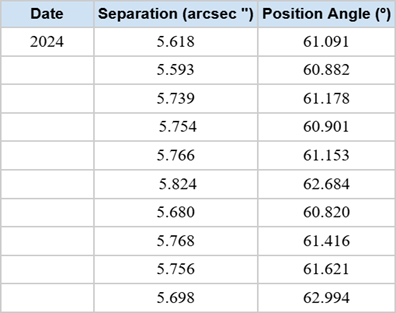
Table 2: Measurements with Afterglow Workbench of WDS 07242+1428 J 396 AB, System B
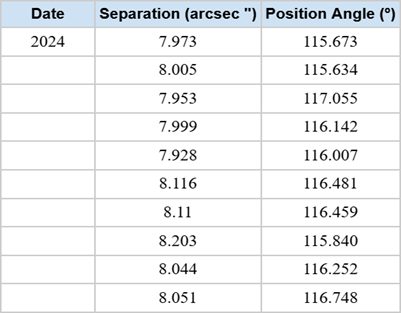
Table 3: Measurements with Afterglow Workbench of WDS 05145+3634 SEI 114 (HD 280693), System C
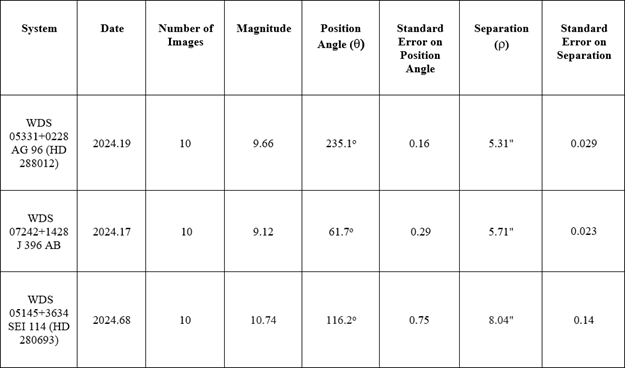
Table 4: Summary of measurements
Results
Our measurements are plotted in Figure 3 with the available historical data for each system for comparison. The horizontal axis is right ascension or RA (arcseconds), and the vertical axis is declination or DEC (arcseconds). The primary star of the system is as noted and the secondary star is plotted on the graph. By plotting the new measurement alongside the historical data, the changes in relative motion of the stars can be seen. The new measurements were compared to the historical coordinates to determine if there was evidence that the systems were binary in nature.
Figure 3a, representing system A, shows the origin at the top right with a star representing the primary star. The different colors indicate different times in which the data was collected, dating back to 1901. The graph indicates that the older points tend to be more widely spaced, while recent data points appear more clustered. This trend may be due to historical telescope limitations, which could have led to less precise measurements in earlier observations. The current data point follows this pattern, as it appears in the middle of the cluster. Since there is little motion toward or away from the primary star in the more recent data, it suggests that this system is likely not gravitationally bound.

Figure 3a: Plot of historical and current data for WDS 05331+0228 AG 96 (HD 288012)
Figure 3b, representing system B, has the origin at the upper left, just off of the graph. A trend seems to appear where the secondary star is moving slightly to the right, increasing in right ascension. The 1911–1943 data cluster (blue) is located around a right ascension of 4 arcseconds, while more recent measurements (orange and red) are closer to 5 arcseconds. This indicates that the star has shifted position gradually over the century and is moving away from the main star.
The declination has had minor changes towards slightly less negative values in more recent observations. There also seems to be two outliers which are noticeably separated from their main cluster. The outlier in the blue cluster is farther to the left, around a right ascension of 3.25 arcseconds, than the rest of the blue points, which are clustered around a right ascension of 4.25 arcseconds. The outlier in the orange cluster is farther to the right than the rest of the orange points, which are clustered around a right ascension of 5.0 arcseconds. These outliers could again be due to historical telescope limitations. Based on the overall trend, this system has the possibility of being either gravitationally bound or simply drifting apart from Earth’s point of view.
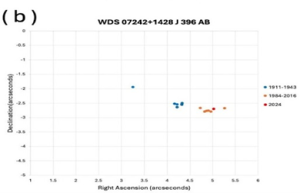
Figure 3b: Plot of historical and current data for WDS 07242+1428 J 396 AB
Figure 3c, representing system C, has the origin at the lower left on the x-axis, just off the graph. The secondary star shows significant changes between data points from 1895-1935 and 2000-2024. Data points in the 1895-1935 range represent an outlier in the data, which may, like systems A and B, be reflective of historical telescope limitations. Over time, there is a very steady decrease in the right ascension and a more significant decrease in the declination. Since 1935, each decade has an even cluster, with each subsequent generation closer to the primary star than the last. These results suggest a shift toward the primary star and an indication that this system may be gravitationally bound.

Figure 3c: Plot of historical and current data for WDS 05145+3634 SEI 114 (HD 28069
Overall, in each system, the number of points is not sufficient to establish a clear orbital pattern. More frequent observations over time are needed to better understand the trajectory of the stars.
Conclusion
By looking at the separation and position angle of the stars and comparing these to historical data points, we made the best possible estimates of whether the systems are gravitationally bound given the available data. Our results suggest that it is unlikely that system A (WDS 05331+0228 AG 96) is binary, whereas systems B (WDS 07242+1428 J 396 AB) and C (WDS 05145+3634 SEI 114) may very well be binary. For each system, further measurements are needed to make more complete conclusions.
While we were unable to reach a confirmatory conclusion on whether the stars are binary, we successfully fulfilled our goal of adding more recent data to each system. In the future, these systems should be analyzed again to see if any changes occur.
Ongoing Work
Upon the conclusion of this research, a scholarly publication of the findings was submitted to the JDSO for consideration in their next journal edition. Publication in the JDSO will make the data from these systems available to WDS via Stelle Doppie and accessible to the greater astronomy community for further research.
Acknowledgements
This research was made possible by the Washington Double Star catalog maintained by the U.S. Naval Observatory, the Stelle Doppie catalog maintained by Gianluca Sordiglioni, Las Cumbres Observatory, and the Afterglow Workbench software.
This work has also made use of data from the European Space Agency (ESA) mission Gaia (https://www.cosmos.esa.int/gaia) and processed by the Gaia Data Processing and Analysis Consortium (DPAC, “http://www.cosmos.esa.int/web/gaia/dpac/consortium). Funding for the DPAC has been provided by national institutions, particularly the institutions participating in the Gaia Multilateral Agreement.
This work makes use of observations taken by the 0.4 m telescopes of Las Cumbres Observatory Global Telescope Network located at the Cerro Tololo Inter-American Observatory, the Teide Observatory in Spain, and the Astronomical Observatory in South Africa.
Contact: ashleyekpo@hotmail.com, vjaramillo019@gmail.com
References
[1] “Stellar Parallax,” Las Cumbres Observatory. https://lco.global/spacebook/distance/parallax-and-distance-measurement/
[2] “The Evolution of Binary Star Systems | Astronomy.” https://courses.lumenlearning.com/suny-astronomy/chapter/the-evolution-of-binary-star-sys tems/#:~:text=Figure%201%3A%20Evolution%20of%20a,to%20become%20a%20red%20giant
[3] “Double Stars – NIU – Department of Physics,” Northern Illinois University. http://www.niu.edu/clas/physics/observatory/honors-project/double-stars.shtml
[4] A. Cermak and N. U. W. Team, “Multiple Star Systems – NASA Science,” NASA Science, Oct. 22, 2024. https://science.nasa.gov/universe/stars/multiple-star-systems/
[5] “IAU Office of Astronomy for Education.” https://astro4edu.org/resources/glossary/term/347/
[6] J. González-Payo and J. A. Caballero, “Discovery of double stars by Giovanni Battista Hodierna in 1654,” Monthly Notices of the Royal Astronomical Society, vol. 533, no. 3, pp. 3379–3386, Aug. 2024, doi: 10.1093/mnras/stae2010.
[7] “What We Know About Double Stars. (George Darwin Lecture, delivered by Dr. R. G. Aitken, Assoc.R.A.S., on 1932 May 13.),” Monthly Notices of the Royal Astronomical Society, vol. 92, no. 7, pp. 596–609, May 1932, doi: 10.1093/mnras/92.7.596.
[8] “The Washington Double Star – Description | USNO.” https://crf.usno.navy.mil/wdstext
[9] J. Gregorio-Hetem, J. R. D. Lepine, G. R. Quast, C. a. O. Torres, and R. De La Reza, “A search for T Tauri stars based on the IRAS point source catalog.,” The Astronomical Journal, vol. 103, p. 549, Feb. 1992, doi: 10.1086/116082.
[10] J. Serot, “Speckle Interferometry of Close Visual Binaries with a 280 …” Journal of Double Star Observations, Jun. 2016. [Online]. Available: http://www.jdso.org/volume12/number5/Serot_488_499.pdf
[11] R.J. Muller et al., “Using the Separation of Double Stars to Obtain the Plate …” Journal of Double Star Observations, Summer 2008. [Online]. Available: http://www.jdso.org/volume4/number3/muller.pdf
[12] E. Berk´O and G. Vask´Uti, “Measures of Double Stars with a DSLR Camera and 35.5-Cm Reflector from 2007.109 to 2007.191,” Double Star Section Circulars, vol. No 16, 2008, [Online]. Available: http://www.webbdeepsky.com/dssc/dssc16.pdf
[13] T. M. Brown et al., “Las cumbres Observatory Global Telescope Network,” Publications of the Astronomical Society of the Pacific, vol. 125, no. 931, pp. 1031–1055, Sep. 2013, doi: 10.1086/673168.
[14] “Gallery image Night View of the Two New Domes Housing 1m Telescopes at Teide Observatory.jpg.” https://lco.global/gallery/image/414/
